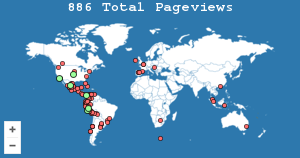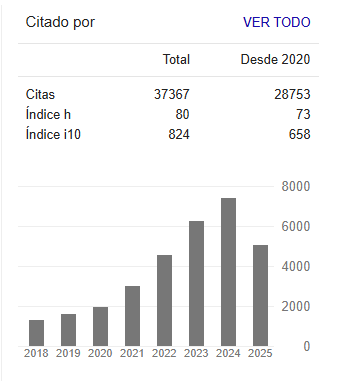Capital psicológico en trabajadores profesionales peruanos: análisis de factores determinantes
Abstract
La fuerza de trabajo en los países iberoamericanos, evoluciona hacia una mayor presencia de trabajadores con educación superior, así el objetivo de esta investigación es determinar la influencia de algunos factores del capital psicológico en los trabajadores activos con título universitario en Lima Metropolitana. Además de analizar la relación entre el capital psicológico y el stress ocupacional en los mismos trabajadores. A través de un estudio de enfoque cuantitativo, de diseño transversal y no experimental, se aplica una encuesta a 395 trabajadores profesionales activos, los datos obtenidos son analizados empleando un modelo de ecuaciones estructurales basadas en covarianzas. El estudio demuestran la existencia de una relación causal significativa entre el balance trabajo-vida y el capital psicológico, asimismo, se comprueba una relación significativa entre los premios e incentivos y el capital psicológico. Finalmente, la investigación concluye que el apoyo social y la autoconfianza son los determinantes clave en el efecto positivo que el balance trabajo-vida y los premios e incentivos tienen sobre el capital psicológico.
References
Azanza, G., Domínguez, Á. J., Moriano, J. A., & Molero, F. J. (2014). Capital psicológico positivo. validación del cuestionario pcq en españa. Anales de Psicologia, 30(1), 294–301. https://doi.org/10.6018/analesps.30.1.153631
Centro nacional de planeamiento estratégico. (octubre 2023). Mayor nivel educativo alcanzado. https://observatorio.ceplan.gob.pe/ficha/t87
Chávez Quispe, L. (10 de noviembre 2023). El burnout sigue en ascenso en el Perú: El 78% de los trabajadores afirman que lo experimentan. Forbes Perú. https://forbes.pe/capital-humano/2023-11-10/el-burnout-sigue-en-ascenso-en-peru-el-78-de-trabajadores-afirma-experimentarlo
Chen, M. (2019). The Impact of Expatriates’ Cross-Cultural Adjustment on Work Stress and Job Involvement in the High-Tech Industry. Frontiers in Psychology, 10(October), 1–10. https://doi.org/10.3389/fpsyg.2019.02228
Dash, G., & Paul, J. (2021). CB-SEM vs PLS-SEM methods for research in social sciences and technology forecasting. Technological Forecasting and Social Change, 173(June), 121092. https://doi.org/10.1016/j.techfore.2021.121092
Department for Business Innovation and Skills (2013). Benefits of participating in higher education: key findings and reports quadrants. https://assets.publishing.service.gov.uk/government/uploads/system/uploads/attachment_data/file/254101/bis-13-1268-benefits-of-higher-education-participation-the-quadrants.pdf
Dragano, N., & Lunau, T. (2020). Technostress at work and mental health: concepts and research results. Current Opinion in Psychiatry, 33(4), 407–413. https://doi.org/10.1097/YCO.0000000000000613
Estrada-Araoz EG, Gallegos-Ramos NA, Paredes-Valverde &, Quispe-Herrera R. Relationship between workload and psychological capital in a sample of Peruvian basic education teachers. Salud, Ciencia y Tecnología, 4, 864. https://doi.org/10.56294/salucyt2024864
Fornell, C., & Larcker, D. F. (1981). SEM with Unobservable Variables and Measurement Error. In Algebra and Statistics, 47(3), 138-145. https://doi.org/10.2307/3150980
García-Salirrosas, E.E., Rondón-Eusebio, R.F., Geraldo-Campos, L.A., Acevedo-Duque, A. (2023). Job Satisfaction in Remote Work: The Role of Positive Spillover from Work to Family and Work–Life Balance. Behavioral Science, 13(11) 1-22. https://doi.org/10.3390/bs13110916
Hair, J. F., Ringle, C. M., & Sarstedt, M. (2011). PLS-SEM: Indeed a silver bullet. Journal of Marketing Theory and Practice, 19(2), 139–152. https://doi.org/10.2753/MTP1069-6679190202
Hair Jr., J., Hult, T., Ringle, C., Sarstedt, M., Danks, N., & Ray, S. (2021). Review of Partial Least Squares Structural Equation Modeling (PLS-SEM) Using R: A Workbook. In Structural Equation Modeling: A Multidisciplinary Journal. https://doi.org/10.1080/10705511.2022.2108813
Hernandez Sampieri, R., Fernández Collado, C., & Baptista Lucio, P. (2014). Metodología de la investigación (6 ta. Edic). Mc Graw Hill Education.
Instituto Nacional de Estadística e Informática. (2023). PERÚ: Comportamiento de los Indicadores del Mercado Laboral a nivel Nacional y en 26 Ciudades Primer Trimestre 2023 Encuesta Permanente de Empleo Nacional-EPEN. www.inei.gob.pe
Krzeminska, A., Lim, J., & Härtel, C. E. J. (2018). Psychological Capital And Occupational Stress In Emergency Services Teams: Empowering Effects of Servant Leadership and Workgroup Emotional Climate (pp. 189–215). https://doi.org/10.1108/S1746-979120180000014017
Kwok, S. Y. C. L., Cheng, L., & Wong, D. F. K. (2015). Family Emotional Support, Positive Psychological Capital and Job Satisfaction Among Chinese White-Collar Workers. Journal of Happiness Studies, 16(3), 561–582. https://doi.org/10.1007/s10902-014-9522-7
Lange, M., & Kayser, I. (2022). The Role of Self-Efficacy, Work-Related Autonomy and Work-Family Conflict on Employee’s Stress Level during Home-Based Remote Work in Germany. International Journal of Environmental Research and Public Health, 19(9), 4955. https://doi.org/10.3390/ijerph19094955
Li, Z., Yu, Z., Huang, S. (Sam), Zhou, J., Yu, M., & Gu, R. (2021). The effects of psychological capital, social capital, and human capital on hotel employees’ occupational stress and turnover intention. International Journal of Hospitality Management, 98, 103046. https://doi.org/10.1016/j.ijhm.2021.103046
Lu, Y., Hu, X. M., Huang, X. L., Zhuang, X. D., Guo, P., Feng, L. F., Hu, W., Chen, L., Zou, H., & Hao, Y. T. (2017). The relationship between job satisfaction, work stress, work-family conflict, and turnover intention among physicians in Guangdong, China: A cross-sectional study. BMJ Open, 7(5), 1–12. https://doi.org/10.1136/bmjopen-2016-014894
Luthans, F., Youssef, C. M., & Avolio, B. J. (2007). Psychological Capital: Developing the Human Competitive Edge. In Psychological Capital: Developing the Human Competitive Edge. https://doi.org/10.1093/acprof:oso/9780195187526.001.0001
Malhotra, N. K., Kim, S. S., & Patil, A. (2006). Common method variance in IS research: A comparison of alternative approaches and a reanalysis of past research. Management Science, 52(12), 1865–1883. https://doi.org/10.1287/mnsc.1060.0597
Mensah, J., & Amponsah-Tawiah, K. (2016). Mitigating occupational stress: The role of psychological capital. Journal of Workplace Behavioral Health, 31(4), 189–203. https://doi.org/10.1080/15555240.2016.1198701
Moccia, S. (2016). Felicidad en el Trabajo. Papeles Del Psicólogo, 37(2), 143–151. https://doi.org/http://www.redalyc.org/articulo.oa?id=77846055007 Cómo
O’Neill, J. W., & Davis, K. (2011). Work Stress and Well-being in the Hotel Industry. National Institues of Health, 30(2), 385–390. https://doi.org/10.1016/j.ijhm.2010.07.007.Work
Organización de los Estados Iberoamericanos (2023). Papeles del Observatorio. Panorama de la educación superior en Iberoamérica a través de los indicadores de la Red INDICES. OEI. https://oei.int/oficinas/argentina/publicaciones/panorama-de-la-educacion-superior-en-iberoamerica-a-traves-de-los-indicadores-de-la-red-indices
Organización Mundial de la Salud- OMS (2023). Estrés. https://www.who.int/es/news-room/questions-and-answers/item/stress?gad_source=1&gclid=Cj0KCQjw5ea1BhC6ARIsAEOG5pzmyqdpy6kbZSEzlwX-iel_YWFRPJnXSTjmF2FRM0Mx-Z7Jc_AIXDoaAn0vEALw_wcB
Parray, Z. A., Shah, T. A., & Islam, S. U. (2023). Psychological capital and employee job attitudes: the critical significance of work-life balance. Evidence-Based HRM: A Global Forum for Empirical Scholarship, 11(3), 483–500. https://doi.org/10.1108/EBHRM-07-2022-0160
Pérez, J., Bustos, J., Vanegas, M., y Barrientos, C. (2023). Capital psicológico, expectativas y compromiso organizacional en el contexto del teletrabajo de los trabajadores mexicanos. Revista Visión Gerencial, 22(2), 257-272. http://erevistas.saber.ula.ve/visiongerencial
Rojas, N. G. (2007). Implicaciones de la Autoeficacia en el rendimiento deportivo. Pensamiento Psicológico, 3(9), 21–32. https://www.redalyc.org/pdf/801/80103903.pdf
Said, R. M., & El-Shafei, D. A. (2021). Occupational stress, job satisfaction, and intent to leave: nurses working on front lines during COVID-19 pandemic in Zagazig City, Egypt. Environmental Science and Pollution Research, 28(7), 8791–8801. https://doi.org/10.1007/s11356-020-11235-8
Salessi, S. (2021). Capital psicológico, satisfacción laboral y compromiso organizacional en tiempos de covid-19: un estudio con personas docentes argentinas. Revista Puertorriqueña de Psicología, 33(2), 244-257. https://doi.org/10.55611/reps.3302.04
Sinniah, S., Mohamed, R. K. M. H., Alam, S. S., Nadarajan, R., Shukor, S. F. A., & Aziz, C. N. B. S. A. (2019). Employee intention to join a union in private university. International Journal of Engineering and Advanced Technology, 8(6 Special Issue 3), 962–972. https://doi.org/10.35940/ijeat.F1078.0986S319
Solakis, K., Peña-Vinces, J., Lopez-Bonilla, J. M., & Aguado, L. F. (2021). From value co-creation to positive experiences and customer satisfaction. A customer perspective in the hotel industry. Technological and Economic Development of Economy, 27(4), 948–969. https://doi.org/10.3846/tede.2021.14995
Tian, G., Wang, J., Zhang, Z., & Wen, Y. (2019). Self-efficacy and work performance: The role of work engagement. Social Behavior and Personality: An International Journal, 47(12), 1–7. https://doi.org/10.2224/sbp.8528
Valencia, J., & Castaño, J. (2022). Organizational Communication and Happiness at Work. Investigación & Desarrollo, 30(3), 191–218. https://dialnet.unirioja.es/servlet/articulo?codigo=8575861
Xu, Q., Hou, Z., Zhang, C., Yu, F., & Li T. (2022). Career Capital and Well-Being: Configurational Perspective. International Journal of Environmental Research and Public Health, 19(16), 1-10. https://doi.org/10.3390/ijerph191610196
Zhang, D., Zhang, F., Lin, M., & Du, H. S. (2017). Knowledge sharing among innovative customers in a virtual innovation community. Online Information Review, 41(5), 691–709. https://doi.org/10.1108/OIR-08-2016-0226
Zientara, P., Adamska-Mieruszewska, J., & Bąk, M. (2023). Unpicking the mechanism underlying hospitality workers’ intention to join a union and intention to quit a job. Evidence from the UK. International Journal of Hospitality Management, 108(May 2022), 103355. https://doi.org/10.1016/j.ijhm.2022.103355
Zientara, P., & Kuczynski, G. (2009). Employees’ Desire to join or leave a unión: Evidence from Poland. Industrial Relations, 48(1), 185–192. https://www.researchgate.net/publication/228311082_Employees_Desire_to_Join_or_Leave_a_Union_Evidence_from_Poland
Zurita Altamirano, J., Llerena Barreno, E. A., Guerrero Velastegui, C. A., & Fierro Altamirano, S. (2023). Motivación laboral del personal y productividad elementos esenciales para el desarrollo organizacional. Dominio de Las Ciencias, 9, 106–131. https://dominiodelasciencias.com/ojs/index.php/es/article/view/3576

This work is licensed under a Creative Commons Attribution-NonCommercial-ShareAlike 4.0 International License.








.png)






























